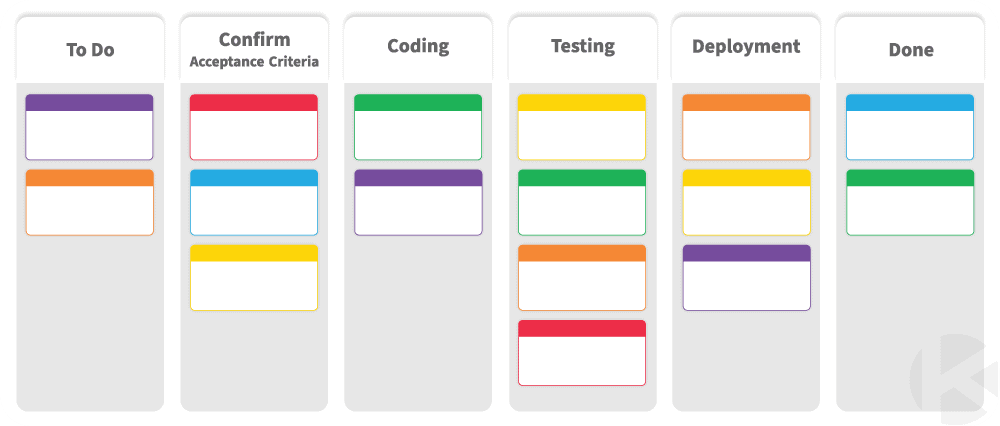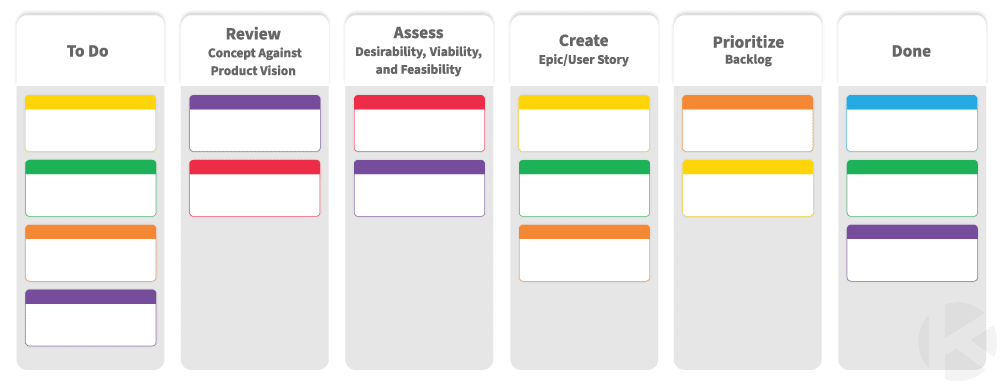Kanban: Visualize the Workflow

A fascinating fact about the human brain is its capability to process visuals 60,000 times faster than text. This means we consume visual content, such as images, much faster than text. As a visual project management tool, Kanban leverages the human brain’s preference for visual content and helps teams understand and analyze what happens in their work. Instead of reading a written report about how your team is doing, you can visualize the workflow better through a Kanban board. A Kanban board represents your workflow, which can help you efficiently diagnose weak points in your process.
Given that Kanban focuses on the workflow, you must know how you are doing the work. Thus, visualizing your workflow is first and foremost to any Kanban implementation.
Why you need to visualize workflow
Visualizing your workflow is the first step in implementing Kanban for a good reason. To improve any process, it is essential to understand how the process currently works. A visualized workflow is the key input to a Kanban system where you have each step in the process corresponding to a column or lane in your Kanban board.
In Kanban, to visualize workflow means to examine the flow of work. This enables teams to analyze the amount of work that comes into their Kanban system, better understand how they process it, and ultimately optimize their process by introducing incremental improvements. With the process optimized, team members are better equipped to achieve continuous delivery and better results.
How to visualize your workflow
Mapping out your process can seem to be a daunting task. You might be overwhelmed by the sheer amount of work that gets into creating your product or service that you think it’s difficult to visualize your workflow in the first place.
These four simple steps will help you get through your workflow visualization exercise to kickstart your Kanban implementation.
Step 1: Identify the scope of the process you want to visualize
The scope referred to here equates to the start and end points of your process. Business operations can span various interrelated processes. It is essential to determine first which of these processes you would like your Kanban system to focus on. While no rule prevents teams from creating lengthy Kanban workflows, it is ideal that the workflow is manageable enough and is focused on a specific team’s work and goals. An excellent way to identify scope is to determine who is doing the process and what they want to achieve when they execute the process.
Let’s take a web application development process, for example.
There will most likely be a process that deals with product and feature conceptualization or what we can call the Product Discovery process and the actual product development or the Product Delivery process. We can treat these high-level processes as separate workflows where the output of the preceding process is the input to the next process.
Product Discovery is often done by product managers, product owners, UX designers, and probably some development team members to assess technical feasibility. This process aims to determine which features will go into the product or decide what to build. Typical inputs to this process are feature concept or idea briefs, user interviews, and feature requests from actual clients.
To sift through the pile of ideas thrown at the product team, they perform a collaborative discovery process to assess whether the concept is desirable, viable, and feasible. The Product Discovery team can do a series of activities to determine these, wherein their outputs could be user story maps, prototypes, personas, user scenarios, epics, and user stories. All these are then fed into the Product Delivery process where the development team transforms them into actual solutions. Subsequently, the Product Delivery team executes its own series of activities to transform a user story into an actual product feature.
From this example, we can create two Kanban systems where the scope revolves around the goals of these two groups – one is for determining the features that go into the product, and the other is for creating the feature on the product.
As we have seen here, we scoped the process around who performs the work and what they want to achieve. You can use a similar approach when identifying the scope of the process where you want to implement Kanban.
Step 2: Enumerate the steps that go into your process
After pinning down the scope of your process, it’s time to dissect how it works and articulate what goes into making your product or service. Ask yourself, “What will it take for an item to be considered done?”
The inputs and outputs you’ve identified in the first step of this workflow visualization exercise will actually help you enumerate the steps in your process. Those inputs would normally go into the To Do lane in your Kanban workflow in one form or another. Examine how you would take an input, process it, and release it to your customers. Being in the Done lane means the item has successfully passed all the necessary steps in your process and is ready to be released to the customer. Between the To Do and Done lanes, what steps will make you confidently say your product can be released?

From our Product Discovery process sample, we can imagine they perform these steps:

Since the main goal of the Product Discovery process is to determine which features will make the cut, it is natural that some items will fall out of the process. In this case, it’s still considered “done” since the team has decided that a feature will not make it to the product. The Done lane for this particular process can contain “rejected” concepts and “accepted” concepts in the form of epics and user stories, so the team knows they have already decided on the fate of a concept or idea.
Alternatively, our Product Delivery process sample could look something like this:
Taking the prioritized backlog from the Product Discovery process, the Product Delivery team performs these steps to create the actual features in the product.
From our examples, we can also observe that each process step has distinct inputs and outputs. Examining these inputs and outputs will also help you determine the steps in your process.
When enumerating the steps that go into your process, it is important that you do it with your team or at least have a representative from each functional team member so that you get to model your current process as accurately as possible.
Step 3: Translate your process steps to lanes in your Kanban board
Once you know the pieces that go into the question marks in your process flow, it’s now time to put them in your Kanban board.
For our Product Discovery process sample, we have this board:
While we have this for our Product Delivery process:

You can use other terms for the To Do and Done lanes, like Backlog or Ready for To Do and Completed for Done. Any label that makes sense for your team to denote which items you need to start working on and when the work for those items is completed.
You can also group the types of items that you work on by using swimlanes. You can also make your workflows more specific and have sub-steps within a process step. Explore the Kanban board examples to help you visualize the possibilities for your own Kanban board.
4. Do the work and seek to continuously improve
Now that your Kanban board is ready, it’s time to put your workflow to work! Let your tasks navigate their way to your Kanban board and examine the results you get. Your board will help you see the true capacity of your team members within each process step and help you better manage the flow of work by setting WiP limits, for example. You will also learn your process metrics and use these to manage your workflow better. With enough process measurements and metrics available, you can use process improvement models to evolve and change your workflow over time.
Assess your process regularly and refine your workflow as you deem fit. The goal of Kanban is to continuously improve, which should be at the heart of your Kanban adoption.
Get started on visualizing your workflow
It’s time to sit with your team and reflect on your current workflow. We suggest not making it a formal meeting but a collaborative conversation instead so that everyone feels comfortable pitching in their ideas and accounts for what really goes on in the work that they do. Whether you use physical materials like markers and whiteboards or choose a Kanban software solution to visualize your process is up to you. The important thing here is to have a collaborative discussion with your team and create a workflow illustration that is as close to your current process as possible. Once you have your workflow visualized, you can start your Kanban implementation.





